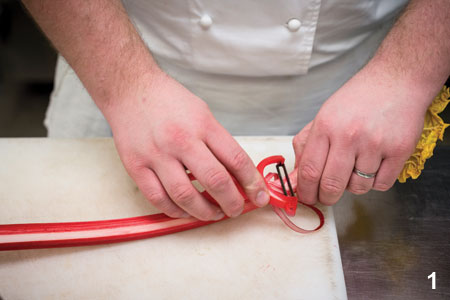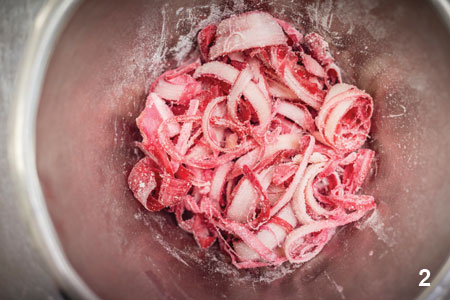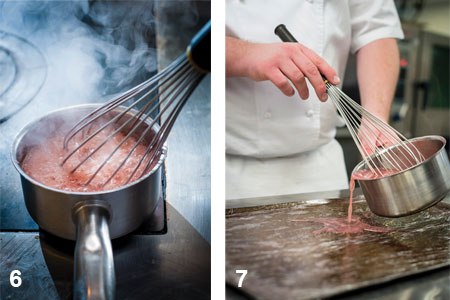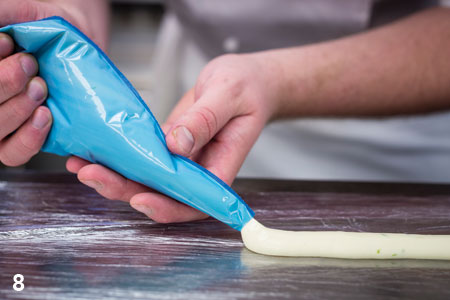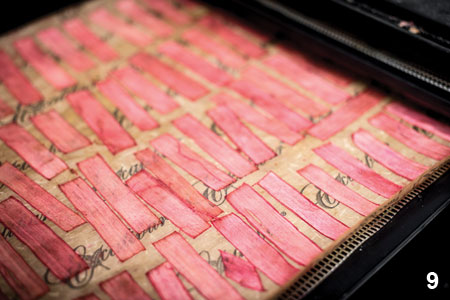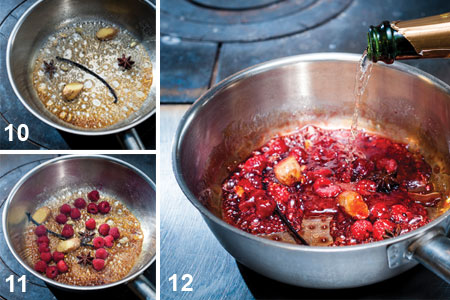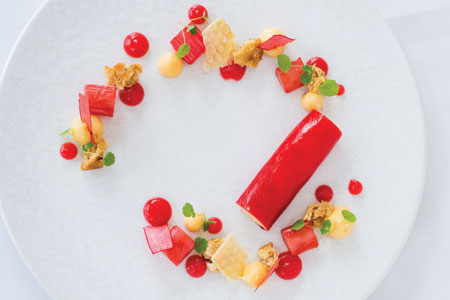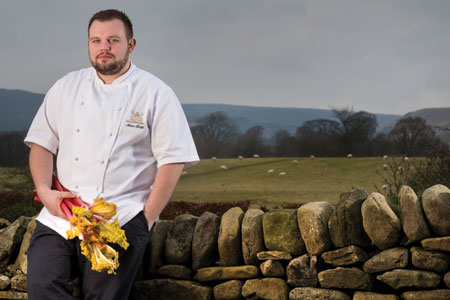Chef masterclass: rhubarb by Adam Smith
The Devonshire Arms' head chef Adam Smith doesn't have to look far to find the finest produce in the Yorkshire Dales to create his celebration of forced rhubarb. Michael Raffael reports
That head start explains why we are better at cooking it than anybody else. Weâve learned to marry rhubarb with strawberries, ginger, lemon, orange, star anise and honey.
In Yorkshire, rhubarb forced in sheds has had a Protected Designation of Origin since 2010, centred on what is imaginatively known as the Rhubarb Triangle. This rhurbarb hits the market in January, and the season continues until April, when the earliest outdoor crop comes on-stream and it can no longer command a premium.
At the Devonshire Arms in Bolton Abbey, North Yorkshire, chef Adam Smith cooks rhubarb crumble for the hotelâs brasserie, but he takes the fruit to another level when creating a dessert for its Burlington restaurant. Here, he has solved the old problem of cooking stems so they donât collapse at the least hint of overcooking.
Cost
The price of forced rhubarb fluctuates between £4 and £5 per kilo. Most restaurants in Yorkshire buy it direct from the grower. The Devonshire Arms offers a £65 à la carte menu and a £75 tasting menu. Both include a pre-dessert and a dessert. The rhubarb dessert is one seventh of an à la carte meal, yielding 74% gross profit â" about £3 per portion.
Planning
The recipe is more about small preparation details brought together on the plate. The poached rhubarb liquor can be prepared ahead in batches and can be scaled up to meet demand. It is the basis of both the cannelloni sheets and the gel. The former have to be prepared daily, but the gel will keep if kept in squeezy bottles.
Rhubarb crisps can be prepared ahead of service and left in the dehydrator. The parfait for the cannelloni can be prepared in batches for two to three daysâ service.
The white chocolate custard can also be made in larger batches when required. Champagne-poached rhubarb is cooked in a water bath, but the chunks of fruit are finished to order by coating them in the glazed syrup.
Both the white chocolate wafers and the cookies used as the garnish are part of basic preparation.
Poached rhubarb juice
This is the base for both the cannelloni and the gel. Peel 8-10 rhubarb stems (the stringy outside) and weigh 500g of the peelings (1).Put
the peelings in a pan with 100g caster sugar and 150g fructose. Sweat them on the side of the stove (2).
Put the stems through a juicer until you obtain 800ml rhubarb juice (3). Combine the juice with the sugar base (4). Put the mixture in vacuum pouches. Seal at maximum pressure and poach for one hour at 63ºC. Strain, chill and reserve (5).
Rhubarb gel
Half a litre of the gel is enough for about 30portions. Bring half a litre of the poached rhubarb liquor to the boil with 7g of agar. Simmer for two to three minutes and then cool and allow to set. Blend in a Vitaprep to obtain a smooth, velvety texture, and transfer to a squeezy bottle ahead of service (6).
Rhubarb cannelloni sheets
300ml of the poached rhubarb juice is enough for a 1/1 gastronorm baking sheet. It will yield 6-8 cannelloni.
Heat the poached rhubarb liquor. Add 14g of gelatine leaves, which have been soaked to soften them. Combine well. Line a gastronorm sheet with film or silicone paper. Coat with a non-stick spray. Spread the rhubarb over it in an even layer, and then refrigerate to set (7).
Parfait mix for cannelloni
Makes about 1 litre or 16-20 cannelloni
- 130g sugar
- 130g egg yolks
- 2g soaked gelatine
- 325g yogurt
- 40g yogurt powder
- 350ml whipping cream
- 85g caster sugar
- Grated zest of lime
Moisten the sugar with water and boil to 109ºC. While itâs heating, start to whisk the yolks. Pour the boiling sugar onto the yolks and continue whisking to obtain volume (a basic sabayon). While itâs still hot, fold in the gelatine and, before it sets, fold in the yogurt mixed with the powdered yogurt.
Whisk the cream and caster sugar to a semi-whipped dropping consistency, add the grated lime zest and fold into the sabayon base. Chill. Prepare double sheets of clingfilm, roughly 30cm long. Fill a disposable piping bag with the parfait and cut the end to make a nozzle about 1cm across. Pipe a strip of parfait onto the film. Wrap the film around the parfait and tighten the ends of the film. Freeze at -18ºC.
Each cylinder should yield two cannelloni (8).
Rhubarb crisps
Cut the rhubarb into batons and, using a Japanese mandolin, slice as finely as possible. Lay the strips on trays in a dehydrator and brush them lightly with the poached rhubarb juice.
Dry in the dehydrator until crisp and brittle enough to snap (9).
Champagne-poached rhubarb
This recipe is for about four sticks of forced rhubarb, cut into 10cm batons. The thickness and length of individual stems varies, so the quantities and times are guidelines rather than precise. However, the ingredients for the syrup are accurately measured.
- 250g caster sugar
- 1 used vanilla pod
- 4 star anise
- 15g fresh ginger
- 12 green cardamoms
- 120g raspberries
- 120ml Champagne
- 12 x 10cm batons of unpeeled forced rhubarb
Put the sugar, vanilla, anise, ginger and cardamom in a pan and moisten with a little water (10). Boil to a light amber caramel, add the raspberries and take off the heat (11).Cool and add the Champagne (12).
Divide the strained syrup between six vacuum pouches and put two or three rhubarb batons in each one (13). Seal on full pressure and poach for 12 minutes at 65ºC. The rhubarb is ready when it has no hint of rawness but is still firm enough to slice (14).
When an order for the dessert comes to the pâtisserie, boil a little of the poaching liquid until itâs syrupy but not jammy. Cut the batons into slices (less than 3cm) and glaze them rapidly in the syrup (15).
Devonshire Arms Rhubarb Triangle dessert
****Â
Serves one.
Quantities are approximate
- 30g white chocolate custard
- 20g rhubarb gel
- 6 pieces of glazed, poached rhubarb
- 1 rhubarb cannelloni sheet
- 20g frozen parfait
- 6 pieces rhubarb crisps
- 6 pieces white chocolate cookie
- 6 shards of white chocolate wafer
- Anise-scented micro-cress
Adam Smith creates a horseshoe design of six miniature desserts on the plate. Each one contains two or three piped droplets of custard and two of rhubarb gel with a piece of glazed poached rhubarb between them.
To make the cannelloni, cut out a rectangle from the sheet, measuring roughly 10cm x 5cm. Cut a piece of frozen parfait to sit neatly on it (16).
Wrap the rhubarb cannelloni around it and trim the edges if necessary. To finish dressing the plate, lay the cannelloni off-centre. On each pile of rhubarb and custard around the plate, add a rhubarb crisp, a piece of cookie, a shard of white chocolate wafer and a sprig of micro cress.
Cookie dough for garnish
For about 30 portions
- 110g soft brown sugar
- 150g caster sugar
- 180g butter
- 5g salt
- 105g egg
- 260g flour
- 5g baking powder
- 260g white chocolate pellets
Make a dough. Cream together the soft brown sugar, caster sugar, butter and salt. Beat in the egg, flour and baking powder and then add the white chocolate pellets. Pour the mixture into a baking tin and bake for 12 minutes at 160°C. Cool and break into small, chewy pieces.
White chocolate custard
Makes about 600ml (about 20 desserts)
- 250ml milk
- 1 vanilla pod, scraped
- 2g leaf gelatine, soaked
- 100g egg yolk.
- 250g white chocolate pellets, melted
Boil the milk with the scraped vanilla pod and then add the soaked leaf gelatine. Whisk in the egg yolk off the heat. Mix the basic custard into the melted white chocolate pellets â" beat in a third and fold in the rest. Cover with film to prevent skinning and chill.
Adam Smith
âThe very, very best chef that has been in my kitchens,â is how the Ritzâs John Williams described his protégé. Adam Smith was awarded an Acorn Award in 2011 and the 2012 Roux Scholarship, and he used his prize to spend three months at the Meurice Hotel in Paris with Yannick Alléno.
From there, he moved to his first head chef job at the Devonshire Arms, Bolton Abbey, in the Yorkshire Dales. When its Burlington restaurant received four AA rosettes this January, Michel Roux said: âIâm so impressed. Yorkshire is so lucky to have such a passionate, gifted chef in its
midst. Adam has shown his true colours as a Roux scholar of exceptional talent and Iâm bursting with pride for him.â
Smithâs style of modern British cookery blends classic flavour combinations in a unique style. His presentations are delicate, but the flavours are strong and punchy. He sources many of his ingredients from producers within an hourâs drive of the hotel, and he will always buy the best possible ingredient demanded by his recipes.



